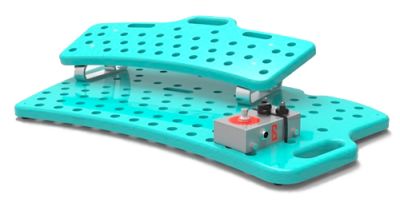
While we all love our stompbox collections, no one loves dealing with pedals that won't stay in place. Some of us might enjoy playing pedalboard Tetris to make all seven pedals accessible on a 14 inch-wide rectangle, but for the rest, it's a pain. Most of us have at least one pesky pedal that always pops out of place every time you carry your board, or one that requires sniper-like aim to toggle with your boot while playing a show.
Chris Trifilio decided he didn't want to deal with either of those things. He began building Holeyboards, multi-tiered perforated pedalboards that use zip ties in lieu of velcro and rethink how a board should be built. With thousands sold, his boards have found a welcoming home on Reverb. We recently caught up with him to talk about the beauty of zip ties, 19th century construction ideals and sweltering warehouses...
Reverb: It's clear from a glance that Holeyboards are a different kind of pedalboard. Can you describe some of the differences between your design and a more traditional one?
Chris Trifilio: For starters, the Holeyboards have two levels - a Top Shelf and the Main board - so it’s easy to access the pedals in the back row without pointing your toes. I was the first to do this in 2007. The HoleyRisers that hold up the Top Shelf are customer designed and made by me out of 6061 aircraft grade aluminum. They are bulletproof.

Second, there is no velcro anywhere. I use zip ties, which in my opinion are one of the greatest inventions of the 20th century. They are quick, hold tight and are easy to change. They don’t damage your pedals like velcro and adhesives do and they never fall off or move.
Third, the deck is curved to follow the arc of your leg motion for easier, quicker access. These little details make it great. There are also two carry handles are integrated into the board, and I have a lifetime warranty on all of my Holeyboards. They are built like tanks but are lightweight due to all the holes. They weigh as much or less than the other boards out there.
R: What was the inspiration for reinventing the pedalboard in this way?
CT: I’ve been designing products for other people for 17 years, from snow-sleds to blowtorches and medical devices. I’ve spent a career working to make things better. The idea for Holeyboards came when I practiced with a band in an old warehouse that was over 100 degrees on summer nights. I had made my own pedalboard and the pedals, held by velcro, would fall off the board when I carried it because it was so hot. The sticky glue backing created a mess, so that’s when I started prototyping to make a better board. I listen to every guitar player who uses them and try to find out what is and isn’t working, and I constantly make them better.
R: You focus on sustainability in your building methods. Can you describe the manufacturing process a bit more?

CT: It starts locally, with all parts purchased and fabricated here in the Twin Cities. I keep the materials pure and simple, sticking with the "truth to materials and honest display of construction" mindset of the late 19th century Arts and Crafts movement. The Baltic Birch Ply is sustainably grown, and I CNC the parts to create the least amount of waste. The aluminum in the HoleyRisers can be easily recycled. Aluminum is actually the lowest impact metal to recycle and was chosen for that reason, alongside its strength-to-weight ratio. The Baltic Birch is shipped primarily in a natural finish, without any harmful chemicals applied. For all of my packaging, I don’t use any harmful dyes. The material is from recycled content where possible. Finally, the Holeyboards are assembled by you, the musician, with a screwdriver and a wrench. As such they are easy to take apart, upgrade or modify.
R: With smaller holes and an elevated section, are there any issues with cables being too thick or too short to make the connections? Are there certain power supplies that Holeyboards aren't compatible with?
CT: The holes are 5/8". That’s over a half an inch, which is actually sizable. All 9V, 12 or 18V power cables, straight and right angle, fit fine and 1/4” straight guitar/patch cords fit fine as well. The beauty of the Holeyboards is that you get to use the power supply you want to use. They all fit, even the Mondo from Voodoo Labs, no problem.
R: Your system uses zip ties instead of velcro. How easy is it to remove a pedal or rearrange them if you only have five minutes before a gig?

CT: You know, one of the comments I get the most from people who have started using the pedalboard is how easy it is to switch out pedals quickly. You clip off the zip tie, place whatever you want, and zip it on. Couldn’t be easier.
R: Does this mean the end of velcro? What about those of us who are nostalgic for that satisfying rip and crunch?
CT: The Holeyboards patent-pending hole pattern was actually designed to allow enough flat surface area so that velcro will also work just fine, so live it up. I would say though, before you make a snap judgement, that sometimes change is good. Having sold almost 2000 Holeyboards since I started, 99.9% of reviews are excellent. They will never go back to velcro. Zip ties are quick, tight, and damage-free forever.
Holeyboard Pedalboards Official